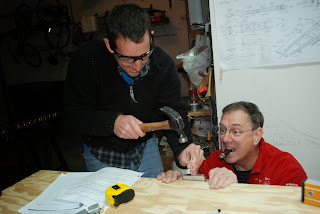This morning was broken up by running yard waste to the county site and casting about for local primer options. The NAPA 7220 was the only option readily available for self-etching primer, so I promptly bought the last can, and after match-drilling and deburring HS-411 and VA-146, put it to work priming the contact surfaces of VA-146.
After allowing it to dry (had to take it inside since temps outside were in the 40s), we proceeded with clecoing the assembly together and squeezing our first rivets!
It was a good feeling to see pieces fixed in their final position. It brings to mind the old saw, "How do you eat an elephant?" We'd taken our first bite.
Natalie helped ensure our alignment was correct.
The rear spar was re-clecoed, and the HS-411 assembly drilled out to #12. We set it aside to begin work on the front spar.
We shaped the ends of HS-711 and HS-714 and bent them to 6 degrees (see on foreground bench, left corner).
My father & I trimmed flanges, drilled relief holes and bent HS-702 to 6 degrees, followed by dimpling the inboard 4 holes. I don't have my countersink set yet so will need to come back and countersink HS-711 and HS-714.
Next was deburring & fluting ribs, and trimming HS-404 to fit around HS-711 and HS-714. Here I encountered my first mistake: I trimmed too far, leaving up to 3/32" where 1/32" was called for.
We moved on to marking, drilling & deburring HS-405 ribs on the forward flange.
Here I discovered my second mistake - I drilled the second hole from the bottom on one rib 1/4" too low.
Fortunately, after calling Van's support, all three mistakes were within tolerance. While not aesthetically symmetrical, all are structurally sound and I've learned to trim even more incrementally and triple-check drilling locations.
That was it for this session. Thanks to my parents for all of their help, can't wait to have you back!
Empennage: 8hrs







































